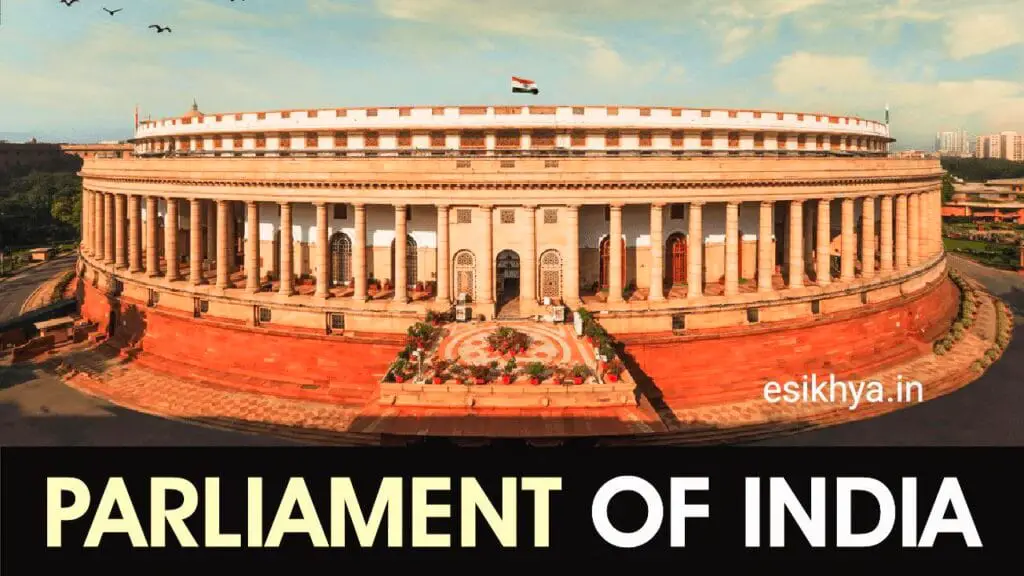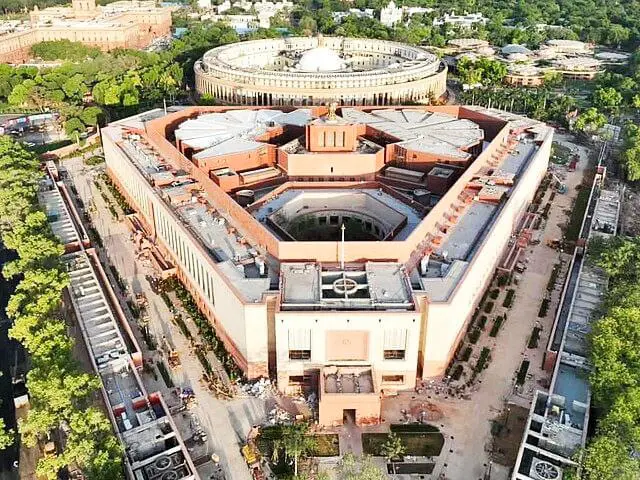
The Parliament of India is the supreme legislative body of the country. It represents the democratic framework of governance, where elected representatives of the people make laws, control finances, and check the actions of the government. The Parliament of India operates under a bicameral system, consisting of two houses: the Rajya Sabha (Council of States) and the Lok Sabha (House of the People), along with the President of India.
Composition of the Parliament of India:
- The Lok Sabha (House of the People):
- The Lok Sabha is the lower house of Parliament and is directly elected by the people of India.
- Membership:
- It consists of a maximum of 552 members:
- 530 members to represent the states.
- 20 members to represent the Union Territories.
- 2 members are nominated by the President from the Anglo-Indian community (this provision was abolished by the 104th Constitutional Amendment Act, 2019).
- It consists of a maximum of 552 members:
- The seats are allocated based on population. Members are elected for a term of 5 years using a first-past-the-post system.
- The Speaker is the presiding officer of the Lok Sabha.
- The Rajya Sabha (Council of States):
- The Rajya Sabha is the upper house of Parliament and represents the states and Union Territories.
- Membership:
- The maximum strength of the Rajya Sabha is 250 members:
- 238 members represent the states and Union Territories.
- 12 members are nominated by the President of India for their expertise in various fields such as literature, science, art, and social service.
- The maximum strength of the Rajya Sabha is 250 members:
- Members of the Rajya Sabha are elected by the elected members of the State Legislative Assemblies through proportional representation. The members serve for a term of six years, and one-third of the members retire every two years, making it a permanent body.
- The Vice President of India is the ex-officio Chairman of the Rajya Sabha.
- The President of India:
- The President is an integral part of the Parliament and plays an essential role in the legislative process.
- The President has the power to summon and prorogue either House of Parliament and dissolve the Lok Sabha.
- No bill can become law without the President’s assent.

Powers and Functions of the Parliament of India:
The Parliament of India has a wide range of powers and performs numerous functions, including legislative, executive, financial, and judicial roles. These powers ensure the smooth functioning of democracy and governance in India.
1. Legislative Functions:
- The primary function of the Parliament is to make laws. It can legislate on matters listed in the Union List, Concurrent List, and, under special circumstances, on matters in the State List.
- Bills can be introduced in either House of Parliament, except Money Bills, which can only be introduced in the Lok Sabha.
- Once a bill is passed by both Houses and receives the President’s assent, it becomes law.
Types of bills include:
- Ordinary Bills: Relating to any matter other than finance.
- Money Bills: Relating exclusively to national taxation or government spending.
- Constitutional Amendment Bills: To amend the Constitution.
- Financial Bills: Involves expenditure from the Consolidated Fund of India but are not classified as Money Bills.
- Private Member Bills: Introduced by members other than ministers.
In cases of disagreement between the two houses, a joint sitting can be summoned, except in the case of Money Bills and Constitutional Amendment Bills.
2. Executive Powers (Control Over the Executive):
- The Council of Ministers, headed by the Prime Minister, is responsible to the Lok Sabha. The Parliament ensures the accountability of the executive by using various mechanisms such as:
- Question Hour: Members can ask questions to ministers regarding their departments.
- Zero Hour: Time allocated to raise urgent public issues.
- Motions: Members can move motions like Adjournment Motions and No-Confidence Motions to hold the government accountable.
- Debates and Discussions: On various national and international issues to guide government policy.
- The executive remains in office only as long as it enjoys the support of the majority in the Lok Sabha. If the government loses the confidence of the House, it must resign.
3. Financial Functions:
- Parliament exercises control over the nation’s finances. The government cannot spend any money or levy taxes without the approval of Parliament.
- The Budget is presented annually in Parliament, where the government presents its revenue and expenditure proposals.
- The Budget includes two parts:
- The Revenue Budget: Deals with revenue receipts (tax and non-tax revenues) and expenditure.
- The Capital Budget: Deals with capital receipts and payments.
- The Finance Bill is introduced in the Lok Sabha, and the Parliament scrutinizes the Budget and suggests modifications.
- Money Bills must originate in the Lok Sabha, and the Rajya Sabha has only recommendatory power regarding these bills. It must return a Money Bill within 14 days, failing which it is deemed passed.
4. Constituent Functions:
- Parliament has the power to amend the Constitution. Constitutional amendments can be introduced in either House of Parliament and require a special majority to pass.
- Certain amendments, which affect federal features, must also be ratified by at least half of the state legislatures.
5. Judicial Functions:
- Parliament performs certain judicial functions, including:
- Impeachment of the President for violation of the Constitution.
- Removal of judges of the Supreme Court and High Courts.
- Punishment for its own members or outsiders for contempt of Parliament.
- In cases of disputes between states or between the center and states, Parliament can intervene under its constitutional powers.
6. Electoral Functions:
- Parliament has a role in electing the President and the Vice President of India.
- Members of both Houses, along with the elected members of the State Legislative Assemblies, form the electoral college for the Presidential election.
- The Vice President is elected by members of both the Lok Sabha and the Rajya Sabha.
7. Deliberative Functions:
- The Parliament acts as a forum for debate and discussion on important national and international issues.
- It is a platform where public opinion is expressed, and national policies are shaped.
Powers and Special Provisions of the Lok Sabha and Rajya Sabha:
- Lok Sabha (House of the People):
- Money Bills can only be introduced in the Lok Sabha, and the Rajya Sabha cannot reject or amend them. It can only suggest changes.
- The Lok Sabha has more power in matters of financial legislation and control over the government.
- The Council of Ministers is collectively responsible to the Lok Sabha, and a government must resign if it loses the confidence of the Lok Sabha (through a no-confidence motion).
- Rajya Sabha (Council of States):
- The Rajya Sabha represents the interests of the states and Union Territories and acts as a check on the Lok Sabha.
- It cannot reject a Money Bill but can discuss and suggest amendments. It must return Money Bills to the Lok Sabha within 14 days.
- The Rajya Sabha is a permanent body, and unlike the Lok Sabha, it cannot be dissolved.
- It has special powers in case of legislation concerning states under Article 249, where it can authorize Parliament to legislate on matters in the State List in the national interest.
Conclusion:
The Parliament of India plays a crucial role in the country’s governance. It represents the will of the people, exercises legislative powers, holds the executive accountable, and controls the nation’s finances. While the Lok Sabha is the more powerful house, especially in financial matters, the Rajya Sabha ensures that the states’ interests are represented. The Parliament, as the cornerstone of India’s democracy, ensures a balance between different branches of government and works toward the collective welfare of the people.